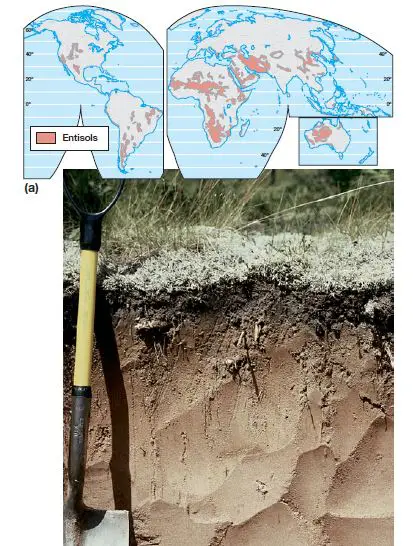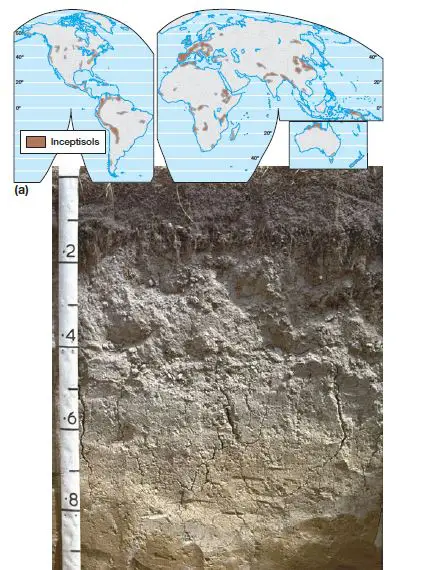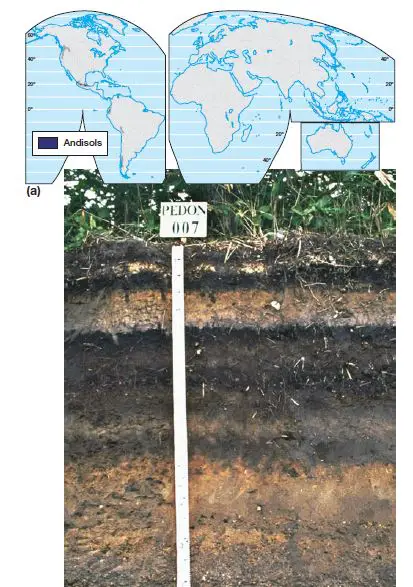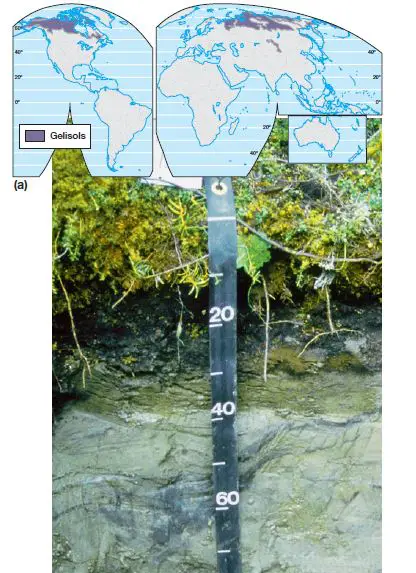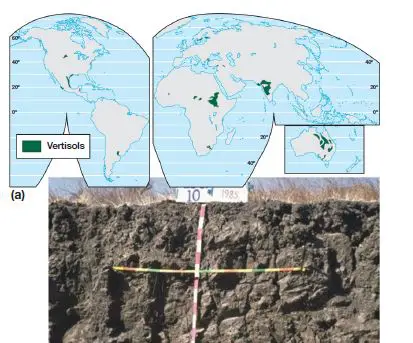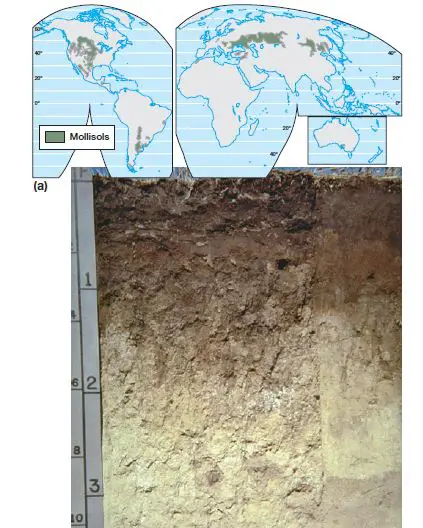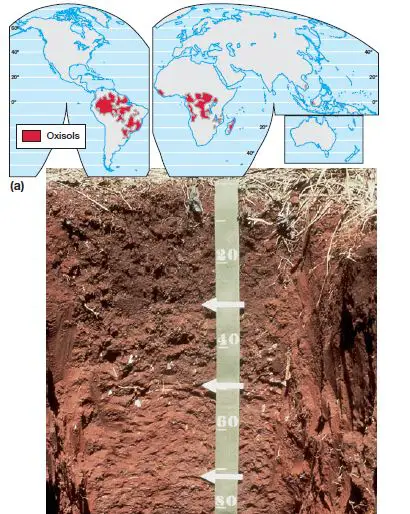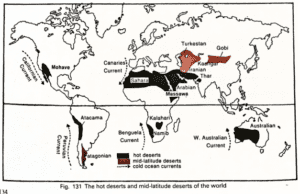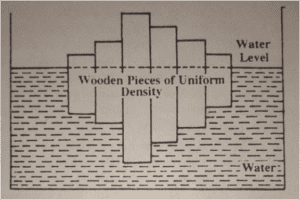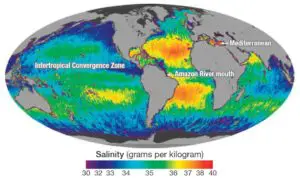Table of Contents
Global Distribution of Major Soil Types in the World | Geography Optional | UPSC
There are twelve (12) orders of soils, which are distinguished largely on the basis of properties that reflect a major course of development, with considerable emphasis on the presence or absence of notable diagnostic horizons. We consider each of the twelve (12) orders, beginning with those characterized by little profile development and progressing to those with the most highly weathered profiles.
- Alfisols – “al” for aluminum, “f” for iron (chemical symbol Fe), two prominent elements in these soils
- Andisols – Rock formed from type of magma in Andes Mountains volcanoes; soils high in volcanic ash
- Aridisols – Dry soils
- Entisols – These are recently formed soils
- Gelisols – Soils in areas of permafrost
- Histosols – These soils contain mostly organic matter
- Inceptisols – Young soils at the beginning of their “life”
- Mollisols – Soft soils
- Oxisols – Soils with large amounts of oxygen containing compounds
- Spodosols – Ashy soils
- Ultisols – Soils that have had the last of their nutrient bases leached out
- Vertisols – Soils in which material from O and A horizons falls through surface cracks and ends up below deeper horizons.
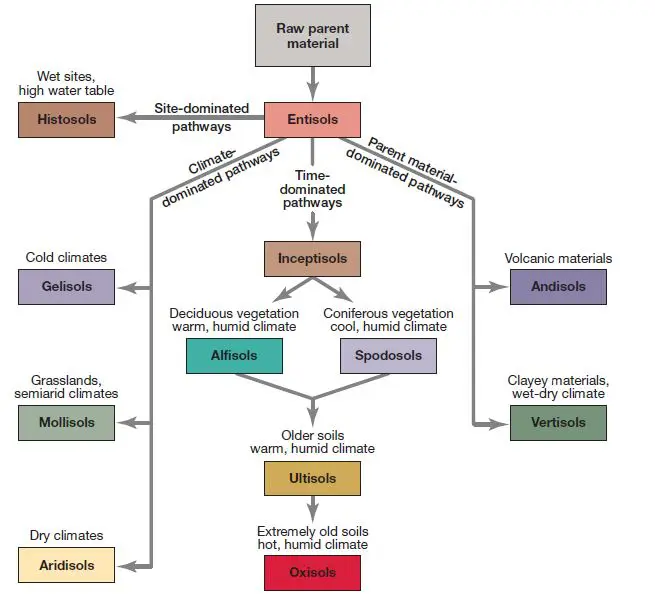 Image – Theoretical soil order development pathways. Soils evolve along “pathways” in which different factors—such as parent material, climate, local site conditions, or length of time – may dominate.
Image – Theoretical soil order development pathways. Soils evolve along “pathways” in which different factors—such as parent material, climate, local site conditions, or length of time – may dominate.
Entisols (Very Little Profile Development)
The least well developed of all soils, Entisols have experienced little mineral alteration and are virtually without pedogenic horizons. Their undeveloped state is usually a function of time (the very name of the order connotes recency).
- Most Entisols are surface deposits that have not been in place long enough for pedogenetic processes to have had much effect. Some, however, are very old, and in these soils the lack of horizon development is due to a mineral content that does not alter readily, to a very cold climate, or to some other factor totally unrelated to time.
- The distribution of Entisols is therefore very widespread and cannot be specifically correlated with particular moisture or temperature conditions or with certain types of vegetation or parent materials.
- In the United States, Entisols are most prominent in the dry lands of the West but are found in most other parts of the country as well. They are commonly thin and/ or sandy and have limited productivity, although those developed on recent alluvial deposits tend to be quite fertile.
Inceptisols (Few Diagnostic Features)
Another immature order of soils is the Inceptisols. Their distinctive characteristics are relatively faint, not yet prominent enough to produce diagnostic horizons. If the Entisols can be called “youthful,” the Inceptisols might be classified “adolescent.”
- They are primarily eluvial soils and lack illuvial layers. Like Entisols, Inceptisols are widespread over the world in various environments. Also like Entisols, they include a variety of fairly dissimilar soils whose common characteristic is lack of maturity.
- They are most common in tundra and mountain areas but are also notable in older valley floodplains. Their world distribution pattern is very irregular. This is also true in the United States, where they are most typical of the Appalachian Mountains, the Pacific Northwest, and the lower Mississippi Valley.
Andisols (Volcanic Ash Soils)
Having developed from volcanic ash, Andisols have been deposited in relatively recent geological time. They are not highly weathered, therefore, and there has been little downward translocation of their colloids.
- There is minimum profile development, and the upper layers are dark. Their inherent fertility is relatively high.
- Andisols are found primarily in volcanic regions of Japan, Indonesia, and South America, as well as in the very productive wheat lands of Washington, Oregon, and Idaho.
Gelisols (Cold Soils with Permafrost)
Gelisols are young soils with minimal profile development. They develop only slowly because of cold temperatures and frozen conditions. These soils typically have a permafrost layer that is a defining characteristic. Also commonly found in Gelisols is cryoturbation or frost churning, which is the physical disruption and displacement of soil material by freeze–thaw action in the soil.
- Most of the soil forming processes in Gelisols take place above the permafrost in the active layer that thaws every year or so. Gelisols are the dominant soils of Arctic and subarctic regions. They occur in association with boreal forest and tundra vegetation.
- Thus, they are primarily found in Russia, Canada, and Alaska and are prominent in the Himalaya Mountain country of central Asia. Altogether nearly 9 percent of Earth’s land area has a Gelisol soil cover.
Histosols (Organic Soils on Very Wet Sites)
Least important among the soil orders are the Histosols, which occupy only a small fraction of Earth’s land surface, a much smaller area than any other order. These are organic rather than mineral soils, and they are invariably saturated with water all or most of the time. They may occur in any waterlogged environment but are most characteristic in mid- and high-latitude regions that experienced Pleistocene glaciation.
- In the United States, they are most common around the Great Lakes, but they also occur in southern Florida and Louisiana. Nowhere, however, is their occurrence extensive.
- Some Histosols are composed largely of undecayed or only partly decayed plant material, whereas others consist of a thoroughly decomposed mass of muck.
- The lack of oxygen in the waterlogged soil slows down the rate of bacterial action, and the soil becomes deeper mostly by growing upward, that is, by more organic material being added from above.
- Histosols are usually black, acidic, and fertile only for water-tolerant plants. If drained, they can be very productive agriculturally for a short while. Before long, however, they are likely to dry out, shrink, and oxidize, a series of steps that leads to compaction, susceptibility to wind erosion, and danger of fire.
Aridisols (Soils of Dry Climates)
- Nearly one-eighth of Earth’s land surface is covered with Aridisols, one of the most extensive spreads of any soil order. They are preeminently soils of the dry lands, occupying environments that do not have enough water to remove soluble minerals from the soil. Thus, their distribution pattern is largely correlated with that of desert and semi-desert climates.
- Aridisols are typified by a thin profile that is sandy and lacking in organic matter, characteristics clearly associated with a dry climate and a scarcity of penetrating moisture. The epipedon is almost invariably light in color. There are various kinds of diagnostic subsurface horizons, nearly all distinctly alkaline.
- Most Aridisols are unproductive, particularly because of lack of moisture; if irrigated, however, some display remarkable fertility. The threat of salt accumulation is nonetheless ever present.
Vertisols (Swelling and Cracking Clays)
Vertisols contain a large quantity of clay that becomes a dominant factor in the soil’s development. The clay of Vertisols is described as “swelling” or “cracking” clay. This clay-type soil has an exceptional capacity for absorbing water: when moistened, it swells and expands; as it dries, deep, wide cracks form, sometimes 2.5 centimeters (an inch) wide and as much as 1 meter (3 feet) deep.
- Some surface material falls into the cracks, and more is washed in when it rains. When the soil is wetted again, more swelling takes place and the cracks close. This alternation of wetting and drying and expansion and contraction produces a churning effect that mixes the soil constituents (the name Vertisol connotes an inverted condition), inhibits the development of horizons, and may even cause minor irregularities in the land surface.
- An alternating wet and dry climate is needed for Vertisol formation because the sequence of swelling and contraction is necessary. Thus, the wet–dry climate of tropical and subtropical savannas is ideal, but there must also be the proper parent material to yield the clay minerals. Consequently, Vertisols are widespread in distribution but are very limited in extent.
- The principal occurrences are in eastern Australia, India, and a small part of East Africa. They are uncommon in the United States, although prominent in some parts of Texas and California. The fertility of Vertisols is relatively high, as they tend to be rich in nutrient bases. They are difficult to till, however, because of their sticky plasticity, and so they are often left uncultivated.
Mollisols (Dark, Soft Soils of Grasslands)
The distinctive characteristic of Mollisols is the presence of a mollic epipedon, which is a mineral surface horizon that is dark and thick, contains abundant humus and basic cations, and retains a soft character (rather than becoming hard and crusty) when it dries out. Mollisols can be thought of as transition soils that evolve in regions not dominated by either humid or arid conditions.
- They are typical of the mid-latitude grasslands and are thus most common in central Eurasia, the North American Great Plains, and the pampas of Argentina.
- The grassland environment generally maintains a rich clay–humus content in a Mollisol soil. The dense, fibrous mass of grass roots permeates uniformly through the epipedon and to a lesser extent into the subsurface layers.
- There is almost continuous decay of plant parts to produce a nutrient-rich humus for the living grass. Mollisols on the whole are probably the most productive soil order.
- They are generally derived from loose parent material rather than from bedrock and tend to have favorable structure and texture for cultivation. Because they are not overly leached, nutrients are generally retained within reach of plant roots. Moreover, Mollisols provide a favored habitat for earthworms, which contribute to softening and mixing of the soil.
Alfisols (Clay-Rich B Horizons, High Base Status)
The most wide ranging of the mature soils, Alfisols occur extensively in low and middle latitudes. They are found in a variety of temperature and moisture conditions and under diverse vegetation associations.
- By and large, they tend to be associated with transitional environments and are less characteristic of regions that are particularly hot or cold or wet or dry.
- Their global distribution is extremely varied. They are also widespread in the United States, with particular concentrations in the Midwest.
- Alfisols are distinguished by a subsurface clay horizon and a medium to generous supply of basic cations, plant nutrients, and water. The epipedon is ochric (light-colored), but beyond that, it has no characteristics that are particularly diagnostic and can be considered an ordinary eluviated horizon.
- The relatively moderate conditions under which Alfisols develop tend to produce balanced soils that are reasonably fertile. Alfisols rank second only to Mollisols in agricultural productivity.
Ultisols (Clay-Rich B Horizons, Low Base Status)
- Ultisols are roughly similar to Alfisols except that Ultisols are more thoroughly weathered and more completely leached of nutrient bases. They have experienced greater mineral alteration than any other soil in the mid-latitudes, although they also occur in the low latitudes.
- Many pedologists believe that the ultimate fate of Alfisols is to degenerate into Ultisols. Typically, Ultisols are reddish as a result of the significant proportion of iron and aluminum in the A horizon. They usually have a fairly distinct layer of subsurface clay accumulation.
- The principal properties of Ultisols have been imparted by a great deal of weathering and leaching. Indeed, the connotation of the name (derived from the Latin ultimos) is that these soils represent the ultimate stage of weathering.
- The result is a fairly deep soil that is acidic, lacks humus, and has a relatively low fertility due to the lack of bases. Ultisols have a fairly simple world distribution pattern.
- They are mostly confined to humid subtropical climates and to some relatively youthful tropical land surfaces.
- In the United States, they are restricted largely to the southeastern quarter of the country and to a narrow strip along the northern Pacific Coast.
Spodosols (Soils of Cool, Forested Zones)
The key diagnostic feature of a Spodosol is a spodic subsurface horizon, an illuvial dark or reddish layer where organic matter, iron, and aluminum accumulate. The upper layers are light-colored and heavily leached. At the top of the profile is usually an O horizon of organic litter. Such a soil is a typical result of podzolization.
- Spodosols are notoriously infertile. They have been leached of useful nutrients and are acidic throughout. They do not retain moisture well and are lacking in humus and often in clay.
- Spodosols are most widespread in areas of coniferous forest where there is a subarctic climate. Alfisols, Histosols, and Inceptisols also occupy these regions, however, and Spodosols are sometimes found in other environments, such as poorly drained portions of Florida.
Oxisols (Highly Weathered and Leached)
The most thoroughly weathered and leached of all soils are the Oxisols, which invariably display a high degree of mineral alteration and profile development.
- They occur mostly on ancient landscapes in the humid tropics, particularly in Brazil and equatorial Africa, and to a lesser extent in Southeast Asia. The distribution pattern is often spotty, with Oxisols mixed with less developed Entisols, Vertisols, and Ultisols. Oxisols’ are totally absent from the United States, except for Hawai‘i, where they are common.
- Oxisols are essentially the products of laterization (and in fact were called Latosols in older classification systems). They have evolved in warm, moist climates, although some are now found in drier regions, an indication of climatic change since the soils developed.
- The diagnostic horizon for Oxisols is a subsurface dominated by oxides of iron and aluminum and with a minimal supply of nutrient bases (this is called an oxic horizon).
- These are deep soils but not inherently fertile. The natural vegetation is efficient in cycling the limited nutrient supply.
